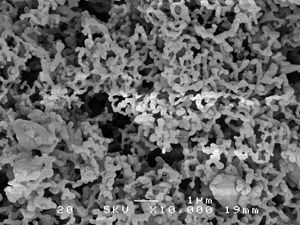Nanocrystals enable lower drug doses
Dosages of medication that dissolve poorly in water, like ibuprofen and the cholesterol-reducing drug fenofibrate, can be reduced if they are administered in the form of nanocrystals. This is what pharmaceutical technologist Hans de Waard claims. He has developed a new technique to turn drugs into nanocrystals. The shape of the crystals makes the drug absorption higher and also much more exact. De Waard will be awarded a PhD by the University of Groningen on 11 March 2011 for research into the preparation of these nanocrystals.
Forty percent of current medication dissolves poorly in the gastrointestinal tract, including drugs such as ibuprofen, the cholesterol-reducing drug fenofibrate, diazepam (better known as Valium) and some HIV blockers. After intake, only part of the medication ends up in the circulation, the rest leaves the body without having been effective. ‘This means that you have to give drugs in high dosages’, says De Waard.
Sugar lump
De Waard investigated the cholesterol-reducing drug fenofibrate in the form of crystals no bigger than two hundred nanometres in diameter (four hundred times thinner than a human hair). The contact surface of such nanocrystals is much larger than in the original medication, which means that the drug dissolves faster. ‘You can compare it with sugar in your tea’, explains De Waard. ‘A sugar lump needs some time to dissolve, whereas a spoon of loose sugar dissolves virtually immediately.’
Freeze-dried
In order to turn drugs into nanocrystals, De Waard developed a new technique based on freeze-drying. A mixture of the drug, a solvent, water and mannitol is cooled extremely fast, resulting in a drug in nanocrystal form encased by a matrix of mannitol. ‘This sugar matrix is very important for the stability’, explains De Waard. ‘Without the matrix the crystals would stick together and form one large crystal.’ In addition to the freeze-drying process, De Waard also developed a spray-freeze-drying method, which enables the process to be applied on an industrial scale.
Freezing speed
De Waard discovered that the size of the nanocrystals depends on the speed of freezing – the faster the freezing process, the smaller the crystals. De Waard: ‘This means that we can also control the final size of the crystals.’ De Waard compares it to making ice cream: ‘The freezing speed also has an effect on the final product when it’s ice cream. A quick freeze results in lovely smooth ice cream, slow freezing creates large water crystals that make it less tasty.’
Fatty foods
In addition to a reduced minimum dosage for drugs in nanocrystal form, it’s also possible to control more exactly how much active ingredient eventually ends up in the circulation. This is currently a particular problem with drugs that don’t dissolve very well because absorption is heavily dependent on the food that is in the digestive tract. De Waard: ‘Drugs that don’t dissolve well in water often do dissolve well in fats. Part of the medication is then absorbed at the same time as fat from the food. That can sometimes mean that high concentrations of the drug suddenly arrive in the circulation.’ According to De Waard, this is not a problem when the drug is in nanocrystal form: ‘The absorption of drugs in nanocrystal form is already much higher. Food thus barely influences the uptake.’
Curriculum Vitae
Hans de Waard (Oss, 1982) studied pharmaceutical sciences and chemical engineering at the University of Groningen. He conducted his PhD research at the department of Pharmaceutical Technology and Biopharmacy at the University of Groningen. The research was financed by Top Instituut Pharma (TIPharma). De Waard’s supervisors at the Faculty of Mathematics and Natural Sciences were Prof. H.W. Frijlink and Dr W.L.J. Hinrichs. His thesis is entitled A novel bottom-up process to prepare drug nanocrystals – the art of the soluble.
Contact
More information: Hans de Waard, e-mail: h.de.waard rug.nl, tel. +31 (0)50 363 2397.

| Last modified: | 24 August 2021 09.13 a.m. |
More news
-
03 April 2025
IMChip and MimeCure in top 10 of the national Academic Startup Competition
Prof. Tamalika Banerjee’s startup IMChip and Prof. Erik Frijlink and Dr. Luke van der Koog’s startup MimeCure have made it into the top 10 of the national Academic Startup Competition.
-
01 April 2025
NSC’s electoral reform plan may have unwanted consequences
The new voting system, proposed by minister Uitermark, could jeopardize the fundamental principle of proportional representation, says Davide Grossi, Professor of Collective Decision Making and Computation at the University of Groningen
-
01 April 2025
'Diversity leads to better science'
In addition to her biological research on ageing, Hannah Dugdale also studies disparities relating to diversity in science. Thanks to the latter, she is one of the two 2024 laureates of the Athena Award, an NWO prize for successful and inspiring...
